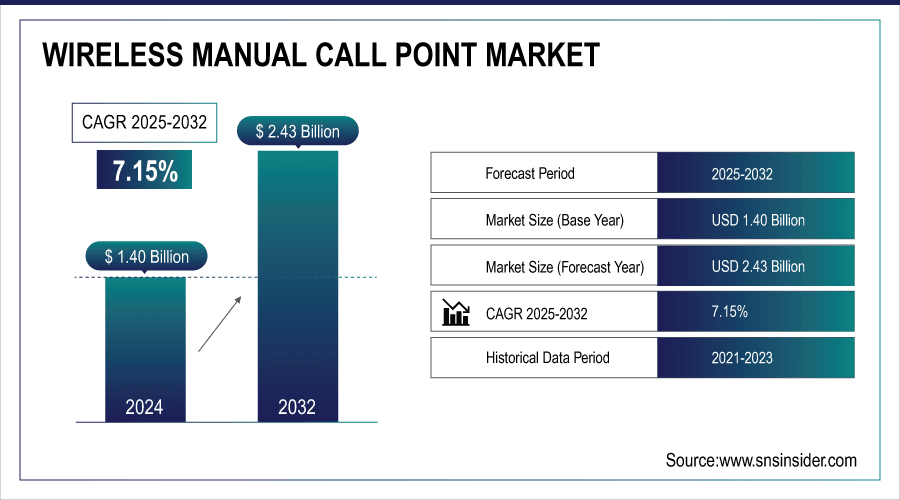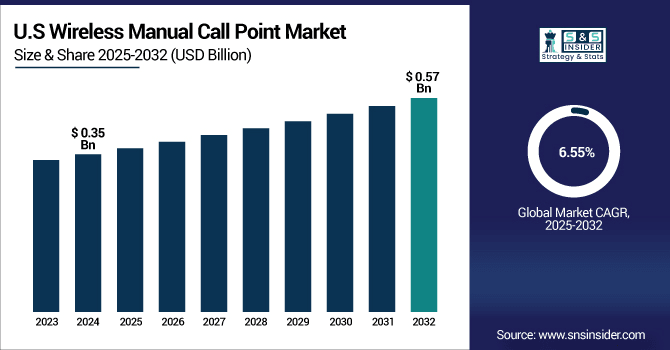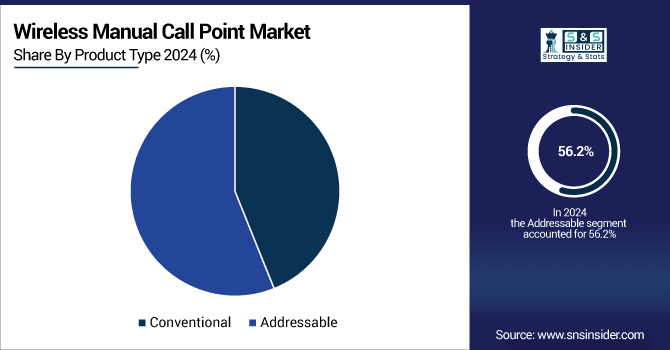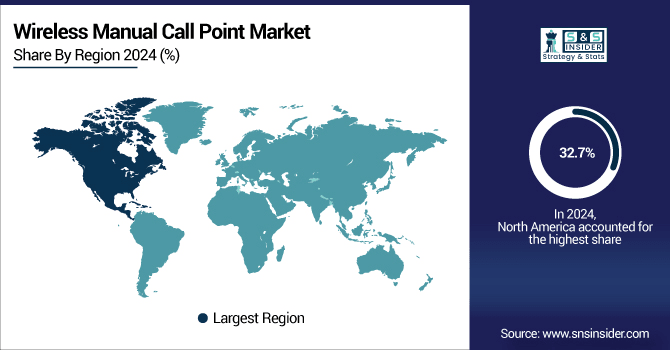Wireless Manual Call Point Market Size & Growth:
The Wireless Manual Call Point Market size was valued at USD 1.40 billion in 2024 and is expected to reach USD 2.43 billion by 2032, growing at a CAGR of 7.15% over the forecast period of 2025-2032.
Global drivers for Wireless Manual Call Point market include increasing fire safety regulations, integration of smart building and quick and convenient service with wireless and low maintenance systems work and installation. Increase in adoption in public and commercial infrastructure provides a lift for market growth especially for AI-powered Addressable systems within Asia Pacific.

To Get More Information On Wireless Manual Call Point Market - Request Free Sample Report
Increasing awareness of fire safety, compliance with stringent regulations, and rapid urbanization are some of the driving factors for the growth of Wireless Manual Call Point market. Smart building technologies transition and the increase in demand for easily installed wireless fire alarm systems are the main reasons. Addressable systems are continuing to grow in popularity, due to their precision and integration capabilities. This will bolster the market growth along with increasing construction activities in commercial and public infrastructure, especially in developing economies, India, and China. Another major factor is the gradual improvement in technology and investment by the government in safety infrastructure.
-
Over 90% of the U.S. states have adopted fire safety codes based on NFPA standards, such as NFPA 72 (National Fire Alarm and Signaling Code), which mandate reliable alarm systems in commercial and public buildings.
The U.S. Wireless Manual Call Point Market size is estimated to be valued at USD 0.35 billion in 2024 and is projected to grow at a CAGR of 6.55%, reaching USD 0.57 billion by 2032. The U.S. Wireless Manual Call Point Market is being driven by more stringent fire safety regulations, growing demand for smart building technologies and the advantages of easily installable wireless fire alarm systems in the commercial and industrial sectors.

Wireless Manual Call Point Market Dynamics:
Key Drivers:
-
Rising Fire Safety Awareness and Smart Buildings Drive Global Wireless Manual Call Point Market Growth
Global Wireless Manual Call Point Market trend is driven by rising awareness about fire safety and the need to meet emerging government regulatory requirements for installations of advanced level of fire alarms at residential, commercial, and public infrastructures. The increasing adoption of smart building technologies that integrate wireless fire alarm solutions is one of the factors that will boost the operational efficiency and installation of the systems, creating opportunities for the growth of the market. The construction industry is seeing increasing demand for newer fire protection systems owing to rapid urbanization and growing construction activities primarily in the developing nations, such as India and China.
-
Dubai's "1 Billion Readiness" program aims to train one billion individuals in fire safety and prevention between 2025 and 2027, collaborating with 34 nations and 16 major firefighting organizations.
Restraints:
-
Limited Awareness and Reliability Concerns Hinder Wireless Manual Call Point Market Adoption Globally
The lack of information and training about the benefits of wireless fire safety systems among facility managers and building operators in some regions is one of the key limits for the growth of the Wireless Manual Call Point market. In more conservative or risk-averse industries, wireless solutions have a harder time taking hold compared to the traditional wired systems considered to be more reliable as part of a legacy of usage. Adoption can also stall if wireless signal reliability is a concern, such as in complex or high-interference environments
Opportunities:
-
Growing Smart Cities and IoT Drive Wireless Manual Call Point Market Opportunities in Developing Regions
There are very large opportunities in developing regions, which are trying to make their infrastructures modern and companies complying with regulations quicker. The increased focus on retrofitting older buildings with wireless systems provides a considerable opportunity in the market. In addition, the growing investment by governments across the globe in the public safety infrastructure and the increasing trend toward smart cities and IoT-enabled buildings, present opportunities for the new meaningful solutions for wireless manual call point. Additionally, the increasing emphasis on environment-friendly and low-maintenance fire safety equipment further provides lucrative opportunities for growth.
-
Smart city initiatives are expected to account for more than 50 billion connected devices by 2025, indicating a substantial integration of IoT technologies in urban infrastructure.
Challenges:
-
Legacy Systems and Regulatory Challenges Slow Wireless Manual Call Point Market Expansion Globally
Another obstacle is the hard-wired manual call points that are a part of the existing building management or fire alarm systems. Due to the combination of legacy infrastructure and modern wireless components, you may run into operational inefficiencies, and you may need to do an extensive rewrite of the whole system. Additionally, maintaining compliance with region-based fire safety codes and certification can further delay time to market by creating hurdles for vendors whose products must get approved in countries with strict and frequently changing regulations, complicating the entry into the market for manufacturers catering to the global front.
Wireless Manual Call Point Market Segmentation Analysis:
By Product Type
Addressable systems accounted for the largest share 56.2% in 2024 and is also anticipated to grow at the highest CAGR between 2025 to 2032. Their high performance is attributed to features including accurate location identification, adaptive systems, and easier integration with modern building management systems. Addressable wireless manual call points allow for real time monitoring and faster response to an emergency unlike traditional systems, which makes them particularly well-suited for large and complex infrastructure.

By effectively reducing false alarms and providing detailed system diagnostic, they improve reliability and operational efficiency. With growing penetration of smart buildings and IoT-enabled infrastructures, scalable fire safety solutions are anticipated to have a growing demand and addressable systems will continue gaining differentiated positioning among commercial, residential and public applications.
By Application
The Wireless Manual Call Point market for commercial buildings accounted for 37.2% of the total revenue share in 2024, due to the rapid adoption of modern-age fire safety systems in offices, malls, hotels and retail outlets are likely to supplement the segment growth. Such environments require fire alarm solutions that are reliable and responsive, to protect occupants and meet the most stringent fire safety requirements. This integration of wireless fire systems in commercial infrastructure is becoming essential, and these systems are continuously implemented in older buildings contributing to the growth of this market segment.
Public buildings are expected to record the fastest CAGR over 2025-2032 as the government continues to invest in safety infrastructure, particularly within schools, hospitals, and transportation hubs. With increasing urbanization and smart city projects, municipalities are being compelled to replace outdated fire systems with advanced wireless solutions. Also, safety regulations in this sector require stricter compliance, and even safety improvements and changes in emergency response methods promote the demand for DSRC-enabled devices as well.
By End-User
Fire Safety held the largest share with 60.4% in 2024 and will lead the Wireless Manual Call Point market & grow at the fastest CAGR during 2025-2032. Such dominance is due to the growing focus on securing lives and property in buildings, whether residential, commercial, or public. The high adoption of wireless manual call points in fire protection frameworks is progressively influenced by stricter fire safety regulations in several regions and the increasing requirement for rapid emergency response systems. This growth is also fueled by the increasing incidence of fire incidents and the integration of new technologies in building safety systems. They provide flexibility, convenience in installation, and economical scale-up, making wireless solutions a fit for new construction and for retrofitting. The sustained emphasis on modernizing safety, specifically in countries that are still developing, and the emergence of smart building, have made the Fire Safety segment a vital and quickly growing segment in the worldwide market of wireless manual call points.
Wireless Manual Call Point Market Regional Insights:
North America was the leading region in the Wireless Manual Call Point market for 2024 with about 32.7% of total share, owing to the early adoption of advanced fire safety technologies coupled with stringent regulatory frameworks. Widespread adoption of wireless fire alarm systems has been fueled by the region's emphasis on improving building safety standards and codes for commercial, industrial, and public infrastructures.

Get Customized Report as Per Your Business Requirement - Enquiry Now
The continuous demand for the market due to a more awareness-free awareness of fire protection and the integration of smart building technologies. The availability of adequately developed infrastructure and an upsurge in expenditure to retro-fit the ageing infrastructure with sophisticated and contemporary safety systems are also accelerating the market growth.
The North American Wireless Manual Call Point market is dominated the by U.S., due to stringent fire safety regulations applicable to every commercial building, the presence of stringent fire safety regulations and enhanced adoption rates toward smart building technologies and the presence of a well-developed commercial and public infrastructure base.
Asia Pacific is anticipated to be the most lucrative market, witnessing a heavy CAGR of 8.23% over 2025-2032 due to rapid urbanization, developing construction activities, and growing consciousness concerning fire safety. In order to modernize infrastructure and mitigate need for maintaining strict safety regulations, the region is witnessing an increasing uptake for wireless manual call point systems. Demand for the market is also being propelled as there is an augmented investment in smart city programs and public infrastructure and burgeoning adoption of the Internet of Things (IoT) and wireless technologies in building management systems. Moreover, surge in demand for scalable, simple to install fire alarm solution for new and retrofit projects is driving robust growth across various sectors.
The rapid advancement of development and infrastructure growth, urbanization, strict fire safety codes, and high government initiative towards smart building provision has led China to conquer the Asia Pacific Wireless Manual Call Point market share.
The Wireless Manual Call Point market in Europe is governed by stringent fire safety and building codes, which explains the penetration of innovative fire alarm system across the region. Awareness regarding safety standards is high in this region, and a growing number of investments is being made to retrofit existing infrastructure with new and emerging wireless solutions. The growth of the market is propelled by the growing smart city projects and incorporation of IoT technologies in residential and commercial buildings. Moreover, a growing focus on sustainability and a reduction in long-term maintenance of fire safety equipment set the stage for market growth across sectors in Europe.
Latin America and the Middle East & Africa (MEA) regions are experiencing growing demand for wireless manual call point systems driven by increasing urbanization and infrastructure development. Governments are investing in upgrading public safety infrastructure and enforcing stricter fire safety regulations. The rising focus on smart city projects and adoption of IoT-enabled building technologies further supports market growth. Despite challenges including budget constraints and varying regulatory environments, the emphasis on modern, easy-to-install, and low-maintenance fire safety solutions presents significant opportunities for wireless system adoption in these regions.
Key Players:
Some of the major Wireless Manual Call Point companies are Siemens, Honeywell, Johnson Controls, Schneider Electric, Bosch, Gentex, Hochiki, Apollo Fire Detectors, UTC Climate Controls, and Tyco International.
Recent Developments:
-
In October 2024, Honeywell introduced the SWIFT® W-BG12, an addressable wireless pull station featuring a dual-action manual pull with a key-lock reset. It integrates into the SWIFT mesh network, offering easy installation and a two-year UL Listed battery life.
-
In June 2024, Gentex showcased its new Commander LED devices at the NFPA convention. These devices are designed to be mounted on standard 1900 boxes and are expected to replace the older Commander 3/4 models. The new LED devices aim to offer improved energy efficiency and modern aesthetics.
| Report Attributes | Details |
|---|---|
| Market Size in 2024 | USD 1.40 Billion |
| Market Size by 2032 | USD 2.43 Billion |
| CAGR | CAGR of 7.15% From 2025 to 2032 |
| Base Year | 2024 |
| Forecast Period | 2025-2032 |
| Historical Data | 2021-2023 |
| Report Scope & Coverage | Market Size, Segments Analysis, Competitive Landscape, Regional Analysis, DROC & SWOT Analysis, Forecast Outlook |
| Key Segments | • By Product Type (Conventional, and Addressable) • By Application (Commercial Buildings, Industrial Buildings, Residential Buildings, and Public Buildings) • By End-User (Fire Safety, Emergency Response, and Security Systems) |
| Regional Analysis/Coverage | North America (US, Canada, Mexico), Europe (Germany, France, UK, Italy, Spain, Poland, Turkey, Rest of Europe), Asia Pacific (China, India, Japan, South Korea, Singapore, Australia, Taiwan, Rest of Asia Pacific), Middle East & Africa (UAE, Saudi Arabia, Qatar, South Africa, Rest of Middle East & Africa), Latin America (Brazil, Argentina, Rest of Latin America) |
| Company Profiles | Siemens, Honeywell, Johnson Controls, Schneider Electric, Bosch, Gentex, Hochiki, Apollo Fire Detectors, UTC Climate Controls, and Tyco International. |

